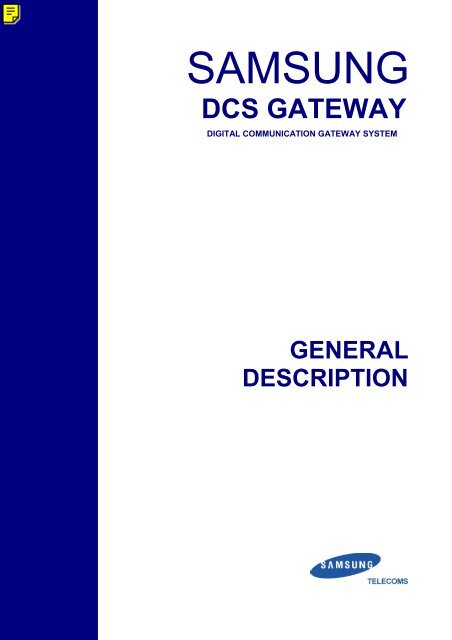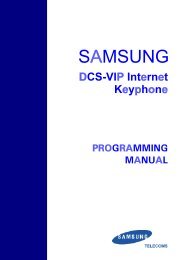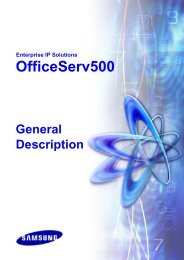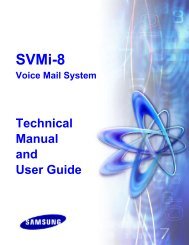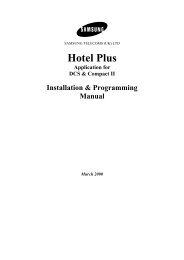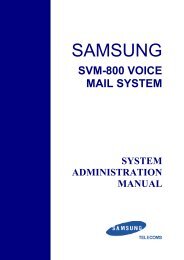dcs gateway general description - Samsung Telephone Systems ...
dcs gateway general description - Samsung Telephone Systems ...
dcs gateway general description - Samsung Telephone Systems ...
Create successful ePaper yourself
Turn your PDF publications into a flip-book with our unique Google optimized e-Paper software.
Publication Information<strong>Samsung</strong> Telecoms reserves the right without prior notice torevise information in this publication for any reason.<strong>Samsung</strong> Telecoms also reserves the right without prior noticeto make changes in design or components of equipment as engineeringand manufacturing may warrant.Disclaimer<strong>Samsung</strong> Telecoms is not responsible for errors or problemsarising from customers not installing, programming or operatingtheir <strong>Samsung</strong> systems as described in this manual.Copyright 2001<strong>Samsung</strong> Telecoms (U.K.) LimitedAll rights reserved. No part of this manual may be reproducedin any form or by any means – graphic, electronic or mechanical,including recording, taping, photocopy or information retrievalsystem – without express written permission of thepublisher of this material.Part No.:16080 Version 1.0
EU Declaration of Conformity (RTTE)<strong>Samsung</strong> Electronics Co., Ltd.259 Gongdan-Dong, Gumi-City Kyungbuk, Korea, 730-030(factory name, address)declare under our sole responsibility that the productDigital <strong>Telephone</strong> Exchange model "DCS Gateway"to which this declaration relates is in conformity withRTTE Directive 1999/5/EC ( Annex II )Low Voltage Directive 73/23/EECEMC Directive 89/336/EEC:92/31/EECBy application of the following standardsEN55022 ; 1995 A1 : 1995 / A2 : 1997EN50082-1 ; 1992EN61000-3-3 ; 1995EN60950 ; 1992+A1 : 1993+A2 : 1993+A3 : 1995+A4 : 1997CTR3/A1 (Commission Decision 98/515/EC)CTR4/A1 (Commission Decision 98/520/EC)CTR21/A1 (Commission Decision 98/482/EC)(Manufacturer)<strong>Samsung</strong> Electronics Co., Ltd259, Gongdan-Dong, Gumi-CityKyungbuk, Korea, 730-030Sung-Chul Hong / General Manager2000-07-03 SC Hong................................................. .................................................................................(place and date of issue)(Representative in the EU)(name and signature of authorized person)<strong>Samsung</strong> Electronics Euro QA Lab.Blackbushe Business ParkSaxony Way, Yateley, HampshireGU46 6GG, UKIn-Seop Lee / Manager2000-07-06 IS Lee................................................. ...............................................................................(place and date of issue)(name and signature of authorized person)
PrefacePrefaceThis guide provides an overview of the <strong>Samsung</strong> DCS Gateway business telephone system, includingsystem structure and hardware, features and facilities, and specifications.Further details on all aspects covered in this guide are included in the <strong>Samsung</strong> DCS Gateway Installationand Maintenance Guides (available to you after completion of an accredited training course) andthe <strong>Samsung</strong> DCS Gateway Feature Description Guide.The DCS Gateway, the latest and largest digital communication system from <strong>Samsung</strong>, employs advanceddigital technology and supports additional features not included in other current models in the<strong>Samsung</strong> DCS range.i
ContentsContentsChapter 1 System OverviewDCS Gateway ....................................................................................................................1-1Features .............................................................................................................................1-2 Networking ................................................................................................................................... 1-2 RMAP............................................................................................................................................ 1-3 ISDN .............................................................................................................................................. 1-3 Hotel / Motel ................................................................................................................................. 1-3 SMDR............................................................................................................................................ 1-4 ACD (Automatic Call Distribution)............................................................................................ 1-5 CTI (Computer Telephony Integration) .................................................................................... 1-5 Multi-Node.................................................................................................................................... 1-5 Announcement.............................................................................................................................. 1-5 External Music ............................................................................................................................. 1-6 Statistics ........................................................................................................................................ 1-6 System Redundancy ..................................................................................................................... 1-6 Maintenance ................................................................................................................................. 1-7Chapter 2 System StructureCabinet Layout .................................................................................................................2-1System Hardware .............................................................................................................2-3Power Cards ...................................................................................................................................... 2-3Control Cards.................................................................................................................................... 2-3Processor Daughterboards ............................................................................................................... 2-4Peripheral Connection Card (IOCB3) ............................................................................................ 2-5Subscriber Cards............................................................................................................................... 2-5Analogue Cards ................................................................................................................................. 2-5Digital Cards...................................................................................................................................... 2-6ISDN Cards........................................................................................................................................ 2-7Service Cards..................................................................................................................................... 2-8Terminals ........................................................................................................................................... 2-8Peripherals......................................................................................................................................... 2-9Appendix: DCS Gateway SpecificationsGeneral Specifications..................................................................................................... A-1Extension Capacity ................................................................................................................A-1Trunk Capacity......................................................................................................................A-1Electrical Specifications .................................................................................................. A-2Signalling Specifications.........................................................................................................A-2Tone Specifications.......................................................................................................... A-5Power Specifications........................................................................................................ A-6Equipment Dimensions ................................................................................................... A-8Weight & Size of Cards ................................................................................................................... A-8ii
Chapter 1System Overview
Chapter 1 System OverviewDCS GatewayThe DCS Gateway is based on a modular design philosophy which allows system software and hardwareto be added cost effectively. Furthermore, the system interface and option cards can be installedinto each shelf’s universal card slots to provide full optimisation and flexibility.The DCS Gateway has capacity for up to 672 ports when equipped with three shelves (the basic shelfplus two expansion shelves). Additionally, up to three DCS Gateway systems can be connected togetherin a multi-node configuration to increase the capacity to 2,016 ports.Each shelf has provision for two power supply cards, a processor card, an analogue ringer card and 10universal card slots.The system is non-blocking and uses a 32-bit main processor (MCPU2). The MCPU2 stores customerdata in Flash RAM, incorporates eight DTMF senders/receivers and generates all tones required tomanage and administer the system. A second processor card can be installed in a dedicated slot in thebasic shelf to provide a back-up processor in the event that the primary processor fails. Expansionshelves each have a shelf processor (LPM3) installed to provide control functions for the cards installedon the shelf and to provide an interface with the MCPU2.The universal card slots (10 per shelf) can have any combination of digital trunks, analogue trunks,digital extensions, analogue extensions or service cards. The first four universal card slots on eachshelf are double density and have 32-port capacity, while the remaining six slots are single densitywith 16 ports. The first four slots are used to install “high-density” cards such as a Primary Rate ISDNcard (30 channels) or a 2 Mbs digital trunk card. If high-density cards are installed in single-densityslots, the slot following the card must be left vacant.Where there are more than 80 digital extensions connected to any shelf, a second power supply cardmust be installed on that shelf in the dedicated slot provided. Where there are less than 80 digital extensionson the shelf, a second power supply card may be installed to provide redundancy. Where analogueextensions are installed, a ringer card (RGPS-K) is required to provide ring signals and messagewaitLED power.1-1
Chapter 1 System OverviewFeaturesThe DCS Gateway provides almost all the features common to the DCS range of business telephonesystems and utilises the same range of digital telephones. The features detailed below are those majorfeatures available that are additional to those found on the smaller DCS models. The <strong>Samsung</strong> DCSGateway Feature Description Guide describes all the features of the DCS Gateway system in moredetail. NetworkingThe DCS Gateway offers many options for networking remote PABXs together. The options delivervarying degrees of feature transparency.QSIGQSIG is an international, open protocol that is used to integrate different manufacturers’ switchingequipment. It is based on the ISDN Q.931 standard. Using QSIG signalling, incoming voice calls canbe routed from one PABX across a private network to a second PABX. QSIG utilises ISDN PRI interfaceswith QSIG-specific EPROMs loaded. QSIG provides a greater level of feature transparencywhen PABXs are networked together than that provided by E & M tie lines.E & M Tie LinesThe 4-wire E & M Tie Line feature is a well-established analogue signalling scheme that is being rapidlysuperseded by digital interfaces with a far higher degree of feature transparency.Internet Gateway (Voice over IP)The DCS Gateway, functioning as an Internet <strong>gateway</strong>, provides a voice communication service viathe Internet or any IP network such as a LAN or WAN. The VoIP interface is the ITM card, which has16 channels. The ITM uses advanced digital voice compression technology to compress voice signalsdown to 6 kHz.Digital Trunk (E1) (Not used in the UK)The DCS Gateway can be connected to remote PABXs via an E1 digital trunk. The E1 trunk has a 2Megabit G.703 interface offering 30 voice channels and providing a simple digital trunk that is commonlysupported by a variety of manufacturers. It does not support ISDN or a high level of feature transparency.1-2
Chapter 1 System Overview RMAPThis is the Windows-based Remote Maintenance & Administration Program (RMAP) package, whichallows DCS Gateway systems to be interrogated and system program changes to be made remotely.The remote DCS Gateway is connected to the PC running RMAP via a modem and the PSTN. ISDNISDN (Integrated Services Digital Network) is a digital network for public communication. It is alsoan integrated information network in which you can use voice communication, visual communicationand data communication simultaneously. ISDN can perform high-speed data communication at a rateof 64Kbps for each channel. The DCS Gateway can provide both ISDN Primary Rate and ISDN BasicRate services. The DCS Gateway supports both T-Bus (public network) and S-Bus (ISDN terminal)connections. Hotel / MotelThe DCS Gateway has a “two way” PMS (Property Management System) interface to connect an industry-standardPMS. The PMS obtains room status information and/or details of call charges from theDCS Gateway. It interfaces with the DCS Gateway to alter guest information via data entered into thePMS, and uses data supplied by the DCS Gateway to compute guest call charges.Features Related to the PMS Interface• Room Check In/Out• Room Status Change• Room Interchange• Room Change• Room Messages• Call Limiting• Detailed Call Billing• Visual Alarm and Wake-Up Call• Suite Room Secretary• Group Registration• Fax Number Designation1-3
Chapter 1 System OverviewFeatures of the DCS Gateway• Service Phones• Booth Phones• Bath Alarm• Wake-up Alarm• House Phones SMDRThe SMDR (System Monitor Detailed Recording) feature is used to manage external (local/toll/international)call information and internal call information for extensions connected to theDCS Gateway. Call information is provided by the DCS Gateway and is normally sent to a TIMS orPMS system for processing and presentation.Call information provided by the DCS Gateway SMDR output is:• Date of call• Time of call• Duration of call• Classification of call (incoming, outgoing, tandem)• Type of call (first/last billing, business/room, CLI, transfer, fax)• Dial type (direct, operator assist, operator direct, LCR, collect, toll free, DISA)• Trunk group number• Tenant number• Phone number of the internal line caller• Phone number of the call recipient (internal/local)• Number dialled• Account code, Forced Authorisation Code1-4
Chapter 1 System Overview ACD (Automatic Call Distribution)The ACD (Automatic Call Distribution) feature is used to distribute calls to Call Centre agents to allowefficient and effective processing of large volumes of incoming calls. The ACD feature uses the“first in first out” (FIFO) principle to distribute calls to agents so that the call waiting for the longesttime will be connected to the first available agent. In addition, each call can be assigned a prioritywhere the highest priority call is connected to the first available agent. Call priority overrides FIFOorder.Where an incoming call is received and there is no agent available to immediately answer the call, thecaller will be served according to how the system is programmed whilst holding for the next availableagent.The ACD feature provides various agent features including:• Up to 32 ACD groups.• Up to 255 ACD agents.• Five queue priority levels.• Log In/Log Out of ACD call transactions.• Message sending/receiving feature to request assistance from the supervisor during the ACD calltransaction.• Emergency feature to inform the supervisor of an emergency situation.• Recording feature to record telephone conversations.• <strong>Telephone</strong> State Change feature.• Work function to allow agents to complete administration work prior to accepting the next call. CTI (Computer Telephony Integration)CTI is the technical integration of computer and telephone communications, where the computer canuse switch features as computer resources and, conversely, the switch can share computer resources. Multi-NodeThe DCS Gateway can have up to three nodes connected together to expand the total capacity up to2,016 (672 x 3) ports. Signalling between nodes is via a 2-Megabit digital tie trunk using <strong>Samsung</strong>proprietary signalling, which provides a high degree of feature transparency. The nodes can be locatedtogether or can be remote from each other. AnnouncementThe Announcement function of the DCS Gateway is used mainly in conjunction with the ACD feature.The DCS Gateway has an optional Automatic Voice Announcement (AVA) card that can provide upto 15 recorded announcements for replaying to callers.1-5
Chapter 1 System Overview External MusicThe DCS Gateway offers the Music On Hold (MOH) function that repeats a specific melody to callerswhile they are on hold. The DCS Gateway has a tone chip on the MCPU card that provides a basicmelody.In addition to the basic melody, the system can have an external music source such as a CD, cassetteplayer or a radio connected via a trunk port to provide music or customer-specific messages. StatisticsThe Statistics function collects data measured during system operation. The output data provided bythe statistics function can be used for diagnosis of system operation, analysis of traffic distribution andimprovement of call quality and service.The data measurement process is divided largely into collection of measurement data, data storage andprocessing, and display of collected data. The statistics data can be output to a printer or a file that isaccessed from the MAP terminal.The types of statistics provided include:• Trunk Group• Extension Group• Function Code• Signalling Device• ISDN Subscriber• Inter-node• Paging System RedundancyThe DCS Gateway has provision for the installation of a second, back-up, main processor in the basicshelf. The second processor operates in standby mode and is automatically switched to active mode ifthe active processor detects a fault condition.A second power supply can also be installed on each shelf to provide a back-up power supply. Wherea shelf has more than 80 digital extensions installed, both power supplies operate in active mode.The redundant main processor card and power supply cards are installed in dedicated slots on theshelves and therefore do not alter the capacity of the DCS Gateway system.1-6
Chapter 1 System Overview MaintenanceThe DCS Gateway provides various tools for efficient maintenance of the system.Maintenance & Administration Program (MAP)MAP is the DCS Gateway operating software, which is installed in a PC connected to the DCS Gateway.The DCS Gateway’s database can be easily searched, edited and controlled using the MAP.Remote Maintenance & Administration Program (RMAP)RMAP provides the facility for remote diagnostics and administration of the DCS Gateway.On-Line Card ExchangeIt is possible to change circuit boards in the DCS Gateway, without the need to power down the system,by attaching an umbilical cord to the boards.Diagnosis FunctionThe diagnosis function is performed continuously in the DCS Gateway so that failures in the systemare notified immediately. The LPM3 card (shelf processor) constantly monitors program commandsperformed by the system such as call tasks, diagnostic tasks, data tasks and the database so that systemabnormalities can be reported.1-7
Chapter 2System Structure
Chapter 2 System StructureCabinet LayoutTop CoverExpansionShelvesPower CardBasic ShelfMain ProcessorSubscriber CardsBasic ShelfThe basic shelf, situated at the bottom of the DCS Gateway cabinet, is where the main control functionswhich manage and control the system are located. The shelf power supply and optional ringercard for analogue telephones are also located on this shelf. In addition, 10 universal card slots areavailable for subscriber cards. The DCS Gateway can operate with only the basic shelf.Expansion ShelfIf additional capacity is required, up to two expansion shelves can be added. Each expansion shelf has10 universal slots where subscriber cards can be installed, along with a shelf processor, a power supplyand an optional ringer card for analogue telephones.Unlike the DCS model, adding expansion shelves to the DCS Gateway does not require the loss of aslot in the basic shelf.2-1
Chapter 2 System StructureTop CoverThe rack cover is attached to the top of the DCS Gateway to prevent dust from entering the system.Terminal BlockThe terminal block at the left side of the basic shelf provides connection points to AC power lines andbattery back-up lines.System Power SwitchThe system power (on/off) switch is situated on the left of the basic shelf .IOCB3 CardThe IOCB3 card provides ports to connect the DCS Gateway with peripherals such as PCs and printersfor the MAP, PMS and SMDR. It is located on the left of the basic shelf.PFT CardThe PFT (Power Fail Transfer) card makes direct connections between analogue extensions and analoguetrunk lines in the event of power failure. One PFT card can be installed on each shelf. Each PFTcard has the capacity for switching 16 analogue lines to 16 analogue telephones. When power is restored,the direct connections will be released.2-2
Chapter 2 System StructureSystem HardwarePower CardsRCMP-D Power CardThe RCMP-D card is installed in a dedicated slot on the extreme left of each shelf in the DCS Gateway.The power card input is AC 240V which is converted into -5VDC, -12VDC, -56VDC, +5VDC, and+12VDC and is then provided to the cards on the shelf. Where there are more than 80 digital telephonesinstalled on a shelf, a second RCMP-D card must be installed on the shelf. Alternatively, asecond RCMP-D card can be installed on a shelf to provide redundancy in the event of power supplyfailure. The second power supply also occupies a dedicated slot.RGPS-K Ringer CardAn RGPS-K (Ring Generator Power Supply) card can be installed on each shelf where it supplies thering current and message-waiting signals to analogue extensions. The RGPS-K card is installed in adedicated Ringer slot located on the right of the RCMP-D power card.The RGPS-K card receives -56VDC from the power card and provides the ring signal with a 20±3Hzor 25±3Hz frequency. The RGPS-K is only required where analogue telephones are connected via theshelf.Control CardsMCPU2 CardThe MCPU2 (Main Control Processor Unit) card has a 32-bit processor. It controls the operation ofthe entire DCS Gateway system, interfacing with each shelf processor and using four types of memory.• DRAM (Dynamic RAM)Stores system software in 2 x DRAMs of 32Mbyte capacity. (Total 64Mbyte)• SRAM (Static RAM)The system database is saved in 2 x SRAMs of 512Kbyte capacity. (Total 1Mbyte)• ROM (Read-Only memory)Contains the system boot-up program. (512Kbyte)• Flash memoryThe system database is saved in four flash memories of 2Mbyte each. (Total 8Mbyte)2-3
Chapter 2 System StructureThe MCPU2 card extracts the network ‘sync’ clock from the ISDN network to provide a synchronizedclock with the DCS Gateway clock. The MCPU2 produces 16 tones for use with the system and haseight DTMF senders/receivers incorporated.The MCPU2 card is always installed in the basic shelf of the DCS Gateway to the right of the RGPS-K card. A second MCPU2 card can be installed as a back-up central processor in the event that themain processor fails.LPM3 CardAn LPM3 (Local Processor Module) card is installed in each expansion shelf of the DCS Gatewaysystem. It controls the subscriber cards and processes signals by sending and receiving messages inconjunction with the MCPU2 card.The LPM3 card is installed in LPM slot 4 or 5 of the expansion shelves.Processor DaughterboardsThe main processor (MCPU2) card can have four types of daughterboard inserted on it. These typesare described below. The MCPU2 card has provision for three such daughterboards. The shelf processor(LPM3) card has provision for up to two daughterboards which can be 4SW cards, CID/R2MFCcards or a combination of both.DTMF (4SW) DaughterboardThe 4SW can be mounted on the MCPU2 card or the LPM3 card and expands the number of DTMFchannels available to the processor to 16. It provides an identical function to the MFM card (see ServiceCards, below) but does not occupy a separate slot. The 4SW card cannot be installed where theCID/R2MFC card is installed (see next) as both cards occupy the same mounting position—in thesecases, the MFM card can be used.Calling Line ID (CID/R2MFC) DaughterboardThe R2CID can be mounted on the MCPU card or the LPM3 card and provides 16 channels for receivingthe R2MFC tone (it cannot send the R2MFC tone). It is required where the analogue Calling LineID (CID) feature is utilised. The CID/R2MFC card and the 4SW card occupy the same slot on theMCPU2 card and therefore both cards cannot be installed at the same time.Channel Extender (TIM) DaughterboardThe TIM daughterboard can be mounted on the MCPU board and provides a time switch requiredwhenever expansion shelves are installed. The three I/O ports, two LPM communication ports, and2-4
Chapter 2 System StructureHDLC communication port are supported in the TIM daughterboard, which extends the number ofhighway channels up to 32.LAN DaughterboardThe LAN card is mounted on the MCPU card and is required to utilise the two LAN ports (I/O 6 – I/O7) on the IOCB3 card.Peripheral Connection Card (IOCB3)The IOCB3 card is located on the left of the basic shelf. It is used to connect peripherals to the systemand comprises six 25-pin serial ports, one 15-pin LAN port and an RJ-45 LAN port.• I/O Port 0Used to connect the MAP PC with the DCS Gateway.• I/O Ports 1–5Used to connect peripherals (such as a printer) with the DCS Gateway.• I/O 6 – I/O 7 PortsUsed to connect the MAP PC with the DCS Gateway through the LAN.Subscriber CardsSubscriber cards are installed in the 10 universal slots available on each shelf. They can be installed inany combination, although cards with more than 16 ports (PRI, DTRK, INI3 etc) must be installed inthe first four slots on each shelf since the subsequent slots (the last six) only have 16 ports available.Analogue CardsSingle Line <strong>Telephone</strong> (GSLC) CardThe GSLC (Subscriber Line Card) is used to connect analogue single line telephones (SLTs).The functions provided by the GSLC card are:• 16 analogue extension circuits.• -56VDC for the connected subscriber telephone.• RING signal that indicates the subscriber telephone is ringing.• Reads the hook on/off status, dial pulse, ring trip and call answer status of the subscriber telephone.• Overvoltage protection for long lines.• Converts analogue signals into digital signals using the PCM method to send them to the control module.It also converts the digital signal into an analogue signal using the PCM method.• Hybrid function to separate the sending path and receiving path from the analogue voice signal.2-5
Chapter 2 System Structure• The message-waiting function on single line telephones.16 PSTN Trunk (GLOOP2) CardThe GLOOP2 (Loop Start Trunk) card is the analogue trunk (PSTN) module and has the followingfeatures:• 16 trunk circuits.• Interfaces with analogue ring in / loop out trunks (PSTN).• Uses either DTMF or Decadic signalling.• Supports polarity reversal sensing of trunks (PRS).• Can provide meter pulse detection (requires MPD modules).• Trunks are used to connect Music on Hold sources.• Can detect calling line identification (CID) signals from the network..E&M Tie Line (G4W E&M) CardThis is the 4-wire E&M tie trunk interface card. 4-wire E&M signalling is a well-established analoguesignalling scheme that is still used extensively in private networks, although it is being rapidly supersededby digital interfaces.The features and functions of the 4W E&M card are:• Supports various types of E&M signalling.• Has six ‘4W E&M’ ports per card.Digital CardsDigital Line Interface Card (DLI4)The DLI (Digital Line Interface) card connects <strong>Samsung</strong> digital telephones to the DCS Gateway. It hasthe following features and functions:• 16 ports per card.• Connects keysets and attendant consoles.• Maximum line length is 800 metres.• Supports keysets with a daughterboard attached to provide an additional keyset or SLT channel.If daughterboards are used in keysets, 32 phones can be connected to this card (16 directly from the systemand a further 16 via the daughterboards in the keysets). When connecting 32 keysets using daugh-2-6
Chapter 2 System Structureterboards, the DLI4 card must be installed in one of the first four slots on each shelf. Alternatively, 32ports can be used (with daughterboards) in the other slots (16-port capacity) but the following slot, adjacentto the card, must be left vacant.Multi-Node (INI3) CardThe INI3 (Inter-Node Interface) card is a 2-Megabit digital tie line interface card and is used primarilyfor interconnection of multiple DCS Gateway nodes. It uses 32 channels in the system and offers thefollowing features and functions:• 2 Megabit G.703 interface.• Uses <strong>Samsung</strong>’s proprietary D-channel signalling protocol.• Provides a high level of feature transparency between DCS Gateway systems.• Has up to 30 voice channels.• Provides links between DCS Gateway systems in a multi-node network..ISDN CardsBasic Rate Interface (BRI) CardThe BRI is the ISDN basic rate interface card. It uses 16 channels in the system and offers the followingfeatures and functions:• Provides ISDN basic rate interface to the network.• Uses ISDN D-channel signalling protocol.• Can be configured as either an S or T interface.• Has eight BRI interfaces of two channels each.As it can be configured as either an S or T interface, it can connect to basic rate interfaces from thenetwork or to terminal equipment such as ISDN phones, videoconferencing equipment, data equipmentand other PABXs.Primary Rate Interface (PRI4) CardThe PRI card has 30 channels and connects to ISDN Primary Rate services. It is also used as the interfacefor QSIG (although it requires a special set of EPROMs for this). It offers the following featuresand functions:• 2-Megabit G.703 interface.• Uses ISDN D-channel signalling protocol.2-7
Chapter 2 System Structure• Provides up to 30 voice and data channels.• Can be configured as either a User or Network interface.• Can extract network clock signals to synchronize the system with the ISDN network.• Provides Direct Dial Inwards (DDI) service.Service CardsDTMF (MFM) CardThe MFM (Multi Frequency Module) card provides 16 additional DTMF senders and receivers. It uses16 ports (one slot) within the system.If there are a large number of analogue telephones connected to the system and the 4SW daughterboardscannot be installed, and there are insufficient DTMF receivers or senders, the MFM card is installedto increase the number of DTMF service ports. Unlike the 4SW daughterboard, the MFM cardoccupies one 16-port slot in the system; it is preferable, therefore, to use the 4SW where possible.Automatic Voice Announcement (AVA2) CardThe AVA2 card stores voice messages for playback by the system. It uses 16 ports (one slot) in thesystem. The AVA2 card is primarily used to provide messages to ACD callers (when used in conjunctionwith the ACD Route Table feature). It can also be used for attendant queue messages and MOH. Ithas 15 recording ports that can each record messages of up to 32-seconds duration. If power is lost tothe AVA2 card, the recorded messages will be held up for up to 72 hours.TerminalsSingle Line <strong>Telephone</strong>sCommonly available SLTs can be connected to analogue ports on the DCS Gateway.<strong>Samsung</strong> Digital <strong>Telephone</strong>s<strong>Samsung</strong> digital phones connect to the DLI4 card. Digital phones used with the DCS Gateway areidentical to those used on the entire DCS range. All phones are fully hands-free and the range comprises:• Executive 24 Button (with display)• Office 24 Button (no display)• Executive 12 Button (with display)• Office 6 Button (no display)2-8
Chapter 2 System Structure• Basic Digital HandsetAdd-On Modules (AOM)An AOM is a digital terminal that extends the number of keys and LEDs on a digital extension. It canprovide facilities such as Direct Station Select (DSS) and Busy Lamp Field (BLF).Attendant ConsoleThe DCS Gateway has a dedicated attendant console for use by a receptionist/operator/system administratorto answer and transfer calls and access DCS Gateway features.DCS Gateway Attendant ConsolePeripheralsModemThe PC running the RMAP is used to monitor and control the status of the system from a remote locationvia a modem. The modem used in the PC for RMAP should:• be an internal modem.• offer transmission rates of 9600–19200 bps.• support a 25-pin RS232C interface.• be IBM PC compatible.PrinterThe printer is used to print system errors occurring in the system, such as status change or system statistics.2-9
Chapter 2 System StructureThe system supports KS and KSSM modes, and any printer which can be connected to an IBMcompatiblePC may be used. It is recommended that a 136-column dot matrix printer be used wherepossible.MAP PCThe MAP is installed on a PC connected to the DCS Gateway to facilitate program changes. The MAPPC sends/receives data through the RS232C port or LAN port of the IOCB3 card.The MAP PC should satisfy the following specifications.• Type : IBM PC compatible (Pentium 133 or higher)• Memory : 32 Mbyte minimum• Monitor : IBM PC compatible over 14" (1024 x 768 resolution, full screen)• Hard Disk : IDE type hard disk with available capacity of approx. 400Mbyte• Floppy Disk : 3.5"• Network Interface Card (NIC)• 9- or 25-pin RS232 port• CD-ROM Drive• Windows 95/982-10
AppendixDCS Gateway Specifications
Appendix DCS Gateway SpecificationsGeneral SpecificationsThe DCS Gateway can support up to 672 ports. The available port capacity will vary depending on theplacement of the interface cards and number of extensions and trunks installed. The following tabledetails the maximum port capacity per configuration.System ConfigurationBasic ShelfBasic Shelf + 1 Expansion ShelfBasic Shelf + 2 Expansion ShelvesMaximum Ports224 ports448 ports672 portsExtension CapacityThe maximum extension capacities for digital keysets, single line telephones and ISDN extensions foreach system configuration are as follows.System ConfigurationStandard <strong>Telephone</strong>sNote)Keysets (seeISDN ExtnsBasic Shelf 160 80/160 160Basic Shelf + 1 Expansion Shelf 320 160/320 320Basic Shelf + 2 Expansion Shelves 480 240/480 480NoteKeyset capacity depends on the number of power (RCMP-D) cards installed in each cabinet. Each RCMP-Dcard supports up to 80 digital keysets.Trunk CapacityThe maximum trunk capacity supported on the DCS Gateway is as follows.System ConfigurationAnalogueDigitalTrunks E&M ISDNBasic Shelf 160 lines 60 lines 160 linesBasic Shelf + 1 Expansion Shelf 320 lines 120 lines 320 linesBasic Shelf + 2 Expansion Shelves 480 lines 180 lines 480 linesA-1
Appendix DCS Gateway SpecificationsElectrical SpecificationsSignalling SpecificationsDTMF Push-Button DiallingSignal Array and FrequencySignal ArrayLowest Cut-off Frequency1 2 3 A 697Hz4 5 6 B 770HzSignal Array7 8 9 C 852Hz* 0 # D 941HzHighest Cut-off Frequency 1209 1336 1477 1633SpecificationFrequency DeviationTransmission PowerLowest Cut-off FrequencyHighest Cut-off FrequencySpecificationWithin ± 1.8% of the frequency-8 ± 2dBm-6 ± 2dBmE&M Tie LineE&M Tie line signalling is used to connect PABX systems. Both TYPE I and TYPE II signalling aresupported. All signalling specifications conform to EIA RS-464.TYPE I can be managed in both the standard and the inverted types.E & M Lead SignallingSignalling Type On-Hook Off-HookTYPE IStandard M Lead : GROUND M Lead : -56VdcInverted M Lead : OPEN M Lead : GROUNDTYPE IIM Lead : OPENM Lead : CLOSEDMA Lead : OPENMA Lead : CLOSEDA-2
Appendix DCS Gateway SpecificationsE1 TrunkElectrical Characteristics of E1 TrunkThe electrical characteristics of the E1 trunk conform to the ITU G.703 and G.704 specifications.Transmission Rate2048kbit/s ± 50ppmCode HDB3 (High Density Bipolar of Order 3)Pulse ShapeCommonly Rectangular Wave: The indication of valid signalmust conform to the mask (G.703) irrespective of thecode.Nominal and Pulse244nsJitter in the input/output TerminalRefer to G.823.Pair in Each Direction 1 Coaxial Pair 1 Symmetrical PairLoad Impedance 75 Ohm 120 OhmIndication (Pulse) Nominal Peak Voltage 2.37V 3.00VVoid (Non-Pulse) Peak Voltage 0 ± 0.237V 0 ± 0.300VSignal Specification and Signalling Method of E1 TrunkThe signal specification and signalling method of the E1 trunk conforms to the ITU G.703 and G.704specifications.Characteristics of ISDN Interface TransmissionElectrical Characteristics of ISDN Interface - BRIThe electrical characteristics of the ISDN (BRI) interface conform to ITU I.430 and ETS 300 012specifications.Transmission RateCodePulse ShapePair in Each DirectionLoad ImpedanceIndication (Pulse) NominalPeak Voltage192kbit/s ± 100ppmAMICommonly Rectangular Wave: The indication of valid signal must conformto the mask (I.403) irrespective of the code.1 Coaxial Cable100 Ohm2.75VA-3
Appendix DCS Gateway SpecificationsElectrical Characteristics of ISDN Interface - PRIThe electrical characteristics of the ISDN (PRI) interface conform to ITU I.431 and ETS 300 011specifications.Transmission Rate2048kbit/s ± 50ppmCode HDB3 (High Density Bipolar of Order 3)Pulse ShapeCommonly Rectangular Wave: The indication of available signal mustconform to the mask (I.403) irrespective of the code.Nominal and Pulse244nsPair in Each Direction 1 Coaxial Pair 1 Symmetrical PairLoad Impedance 75 Ohm 120 OhmIndication (Pulse) NominalPeak Voltage2.37V 3.00VVoid (Non-Pulse) Peak Voltage 0 ± 0.237V 0 ± 0.300VElectrical Characteristics of Digital Line Interface – DLI4The electrical characteristics of the DLI interface are as follows:Transmission RateCodePulse Shape144kbit/sAMI (Alternate Mark Inversion)Typical AMI WaveformA-4
Appendix DCS Gateway SpecificationsTone SpecificationsThe DCS Gateway provides several system tones which all conform to ITU specifications.System TonesThe digital tones are stored in ROM and can support a maximum of 15 channels. The tone on/off periodis programmable. The standard on/off periods for each tone are assigned as follows:Tone Name Abbreviated Form On/Off Period Tone FrequencyExtension Line Dialling Tone dial-tone continuous 350 + 440Transferring Tonexfr-tone0.5/0.20.5/0.1440 + 480Busy Tone busy-tone 0.5/0.5 440 + 480Howler Tone hwlr-tone continuous 941 + 1,203Confirming Tone cnfrm-tone 0.1/0.1 440 + 480Camp-on Tonecamp-tone0.2/0.10.1/0.1440 + 480Hold Tonehold-tone1.0/0.80.25/0.5350 + 440Error Toneerr-tone0.5/0.20.2/0.2440 + 480Trunk Dial Tone exdial-tone Continuous 350 + 440Ring Back Tone rback-tone 2.0/4.0 440 + 480Congestion Tone congst-tone 0.25/0.25 440 + 480A-5
Appendix DCS Gateway SpecificationsPower SpecificationsGrounding ConditionThe grounding resistance between the DCS Gateway and earth should be within 80 Ohm.Power CardVoltage Current Capacity Reference+5Vdc ± 2%8A-5Vdc ± 2%1A+12Vdc ± 10% 0.5A-12Vdc ± 10% 0.3A-56Vdc (R) 0.5A *R : supply for RING SUPPLY-56Vdc [L] 2.1A *L : supply for subscriber’s lineRGPS-K CardThe RGPS-K card supplies analogue phones with ring signal, -56Vdc power and power to messagewaitingLEDs.• Input requirement: -36Vdc – -72Vdc• Output requirementRing Frequency(Hz)Ring Voltage(Volts, Vrms)Maximum Current(A)LineRegulationMaximumPower (W)20 ± 3or25 ± 370 ± 5 0.3 ±10Vrms 28A-6
Appendix DCS Gateway SpecificationsAll ConfigurationsCard Name MIN /Input Voltage/Current (mA)MAX +5V -5V +12V -12V -56V -56VRMCPU2 Bare Board NOR 2190 - 64.3 - - -MCPU2 + 1 4SW NOR 2430 - - - - -MCPU2 + 1 TIM NOR 2910 - - - - -LPM3 NOR 820LPM3 + 1 4SW NOR 1060LPM3 + 2 4SW NOR 1320LPM3 + 1 4SW + 1 CID NOR 1350LPM3 +1 R2CID NOR 1120R2CID: 0.304SW: 0.24LAN: 0.19TIM: 0.724SW NOR 240 - - - - -LAN NOR 190 - - - - -R2CID NOR 300 - - - - -TIM NOR 720 - - - - -GLOOP2MIN 214 122 - - - -MAX 726 202 - - - -G4W E&MMIN 93 49 - - 0 -MAX 280.5 82 - - 24 -PRI4 NOR 380 - - - - -DTRK3 NOR 470 - 100 - - -BRINOR 457 - - - 11 -MAX 457 - - - 91 -INI3 NOR 470 - 100 - - -ITM NOR 770 - 100 - - -ITM SUBNOT USEDGSLCMIN 129 54.2 - - 17.46 -MAX 623.4 188.6 - - 442.1 -DLI4MIN 470 - - - 20 -MAX 470 - - - 452 -MFM MAX 214 96 - - - -AVA2MIN 80 - - - - -MAX 160 - - - - -SIM NOR - - - - 29 -PFT NOR 437 - - - - -R/GMIN - - - - - 78MAX - - - - - 8mA/PA-7
Appendix DCS Gateway SpecificationsEquipment Dimensions• For a rack with three shelves:730(W) x 1,229(H) x 466(D) mm• For a rack with two shelves:730(W) x 859(H) x 466(D) mm• For a rack with one shelf:730(W) x 489(H) x 466(D) mm• The height of the wheel is 68 mm• The height of the rack cover is 50 mm• The height of the shelf is 370 mmWeight & Size of Cards / ModulesItemCONTROLCONTROLD’BOARDCard/Module Weight (kg) Size (cm) RefNameMCPU2 0.85 29.067 x 27.813 x 3 RAM, T-SWLPM3 0.647 29.067 x 27.813 x 34SW 0.0915 11.5 x 0.95 x 1.01LAN 0.0625 8.0 x 12.6 x 1.1R2CID 0.0905 11.5 x 0.95 x 1.1TIM 0.078 12.2 x 12.5 x 0.6DIGITAL DLI4 0.677 29.067 x 27.813 x 3PRI4 0.4685 29.067 x 27.813 x 3DIGITALTRUNKANALOGUETRUNKADDITIONALMODULEDTRK3 (E1) 0.605 29.067 x 27.813 x 3ITM (Sigate) 0.6045 29.067 x 27.813 x 3ITM SUB 0.0515 8.4 x 4.8 x 1.7INI3 0.605 29.067 x 27.813 x 3BRI 0.7265 29.067 x 27.813 x 3GSLC 0.76 29.067 x 27.813 x 3GLOOP2 (A)(PRS, CID, MPD)0.885 29.067 x 27.813 x 3G4W E&M (A) 0.551 29.067 x 27.813 x 3AVA2 0.7095 29.067 x 27.813 x 3PVMSPVMS D’boardMFM (A) 0.586 29.067 x 27.813 x 3PFT 0.266 12.3 x 20.1 x 1.7AC/DC RCMP-D 3.182 28.5 x 27 x 6.05RINGER RGPS-K 1.356 28.5 x 27 x 4.5A-8
Appendix DCS Gateway SpecificationsMISCRACKItemsCard/Module Weight (kg) Size (cm) RefNameMBD_M2+ 2.350 55.232 x 30.701 x 3.45IOCB 0.146 15.3 x 7.9 x 3.2PDB 0.053 14.8 x 7.2 x 1.65DTIR 1.397 19.0 x 15.0 x 4.0SIM (DATA) 0.1705 9.0 x 12.0 x 2.8ATC 1.996 39.8 x 21.0 x 14.5MSIM / DPIM 0.2 9.0 x 12.0 x 2.9A (SHELF #1) 30 73 (70) x 46.6 x 48.9 SIDE: 1.55(B)C (SHELF #3) 20 73 (70) x 46.6 x 37 F/R: 1.953-SHELF RACK 98.15 73 (70) x 46.6 x122.9 (70): RCMP-CA-9
<strong>Samsung</strong> Telecoms (U.K.) LimitedBrookside Business Park, Greengate, Middleton, Manchester M24 1GSTel: 0161 655 1100 Fax: 0161 655 1166


